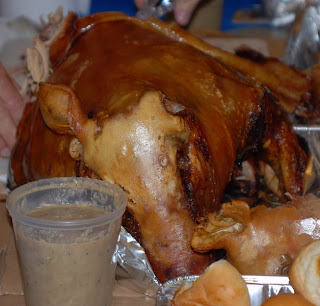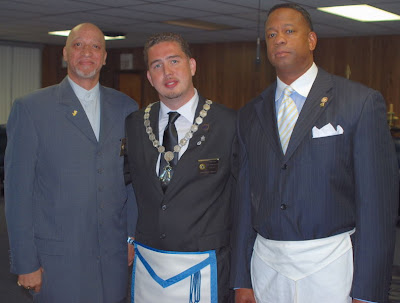This edition of The Magpie Mason is dedicated to Bro. Gallant, who is in search of New York lodges that work Scottish Rite ritual.
Here is a reason to look forward to autumn: Garibaldi Lodge No. 542 will confer its world famous Entered Apprentice Degree on Friday, October 9. The Friday before Columbus Day.
The lodge will open at 8 p.m. in the Grand Lodge Room (third and fourth floors) at the Grand Lodge of New York, located at 71 West 23rd St., near the corner of Sixth Avenue, in Manhattan.
This degree draws visiting brethren from all over the world. The last time I attended – April of last year, I think – the visitors were called upon to introduce themselves, and they hailed from lodges across the United States, and indeed all over the globe. The Grand Lodge Room accommodates approximately 1,200 people, and believe me when I tell you that every seat in the room was occupied. (In fact, the first time I attended – April of 2001, I think – four hundred Masons, mostly those who arrived late on their buses from Pennsylvania, had to be turned away to placate the Fire Marshal, who was poised to close down the building for safety’s sake.)
If you plan to attend, be at the front door of Grand Lodge at 6 p.m. Bring your regalia and membership identification.
But that reminds me of another important observation. The last time I attended an EA° at Garibaldi in the fall – October of 2003, I think – the room was nearly empty. I was able to get one of the best seats in the house, and I’m not saying where that is.
Other facts you should know:
 • Born on the fourth of July 1807, Giuseppe Garibaldi is regarded as “the George Washington of Italy” because his military and political skills were crucial to the unification and establishment of the modern Italian nation-state. And he was not limited to that nation; Garibaldi also fought for independence in Brazil and Uruguay. (It was then that he adopted the red shirt as symbolic attire. At Garibaldi Lodge, you’ll see the officers wearing red dress shirts with their tuxedos.)
• Born on the fourth of July 1807, Giuseppe Garibaldi is regarded as “the George Washington of Italy” because his military and political skills were crucial to the unification and establishment of the modern Italian nation-state. And he was not limited to that nation; Garibaldi also fought for independence in Brazil and Uruguay. (It was then that he adopted the red shirt as symbolic attire. At Garibaldi Lodge, you’ll see the officers wearing red dress shirts with their tuxedos.)After revolutionary exploits in Italy in the late 1840s, Garibaldi went into exile in of all places... Staten Island, New York. So there is a physical proximity of the lodge to its heroic namesake, as well as the ethnic unity. Because of his sojourn in New York City, there is a terrific statue of Garibaldi in historic Washington Square Park. The bronze depicts the warrior with his hand on the hilt of his sword. Is the warrior drawing the weapon, or is the statesman sheathing it?
• The lodge works in Italian, but that does not mean the ritual is incomprehensible to those of us who do not understand the language. Unlike the Preston-Webb-Cross rituals most Masons in the United States know, this ritual is much more physical and expressive and, frankly, dramatic. Its symbolism contains many alchemical elements. I won’t say more.
• Not only are Apprentices and Fellows welcome to attend, but they in fact will be seated in the East with the Worshipful Master, Grand Master, and other dignitaries. Just make sure you introduce them as such to the tilers at the doors.
• Be prepared for a long night. It takes a while to get everyone seated and the lodge brought to order. The degree is longer than that worked in most New York lodges. There are introductions of dignitaries. Maybe the Grand Master will make a speech, as MW Neal Bidnick did last spring... for 45 minutes. My point is, this is not a Broadway production with an audience that can walk out if they’re bored. This is a tiled meeting of a duly constituted and ritually opened lodge. There have been times when visitors, who were so startled by this uncommon ritual, walked out of the lodge. Don’t do that.
• The ritual is “unusual” in that it is uncommon in the United States. There are approximately 10 lodges in Louisiana, several in California, and a few elsewhere that work this ritual. What is it? I call it Scottish Rite. My longtime penpal Bro. Jacques Huyghebaert terms it French Rite. My droog and leader Bro. Piers Vaughan once described it to me as Memphis-Misraim Rite.
I think we all are fundamentally correct, because I don’t think there are material differences separating those three forms of Masonic ritual.
Frère Jacques is co-editor of a very important book on Masonic history and ritual titled “Le Progres de l'Oceanie 1843: The First Masonic Lodge in Hawaii (Sandwich Islands),” which is available from the Grand Lodge of California for about $40. (Seriously, contact Grand Secretary Allan Casalou for a copy of this fascinating piece of research.)
This is a bilingual text of mid 19th century Scottish Rite Craft ritual used by a lodge in Hawaii that was founded by the Scottish Rite Supreme Council of France in 1843. (When you see kings of Hawaii on lists of famous Masons, they were members of Lodge Le Progres de l’Oceanie.) Read the lodge’s history here. Therefore I pay attention when Jacques describes the Garibaldi ritual as French Rite ritual translated into Italian.
Now Garibaldi himself was grand master of the Ancient and Primitive Oriental Rite of Memphis-Misraim, an amalgamation of the Rite of Memphis and the Rite of Misraim, two Masonic orders in Europe that drew from the history and myths of Egypt for their ritual and symbolism. Therefore I pay attention when Piers describes Garibaldi Lodge’s ritual as M-M.
Whatever one wants to call it, it must be experienced. The candidates who enter the Inner Door begin a transformational process. Of course the labor is up to them (and some do not return for the Second Degree), but this highly instructive ritual has the ability to grab the heart and vitals, and set that labor into motion.










































































































